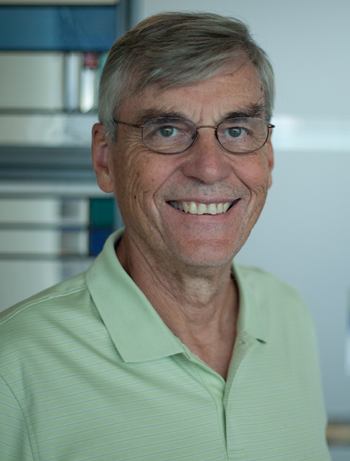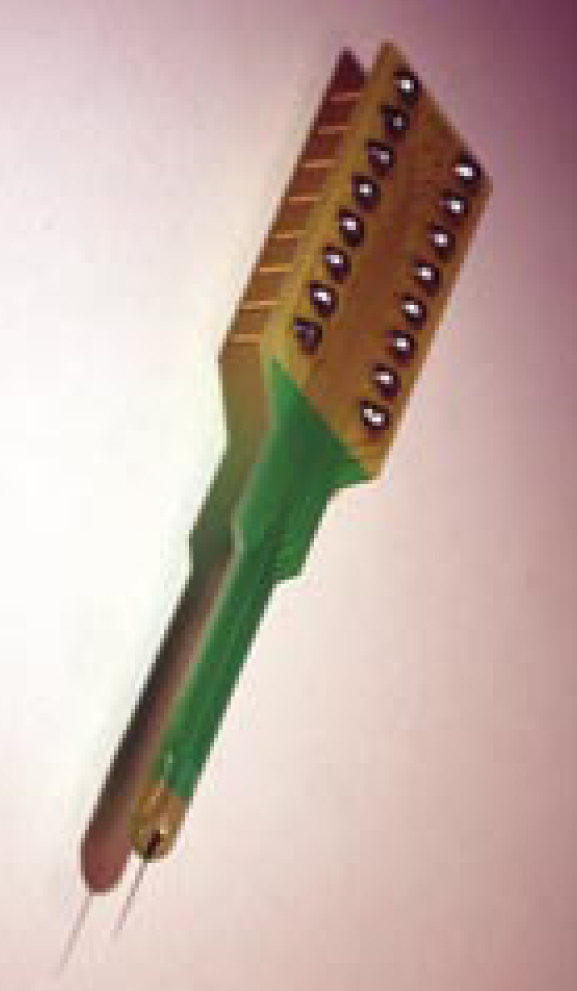David Anderson: Making the connection
“I’ve always been involved in auditory neurophysiology, that’s the thread throughout my career,” said Anderson.

 Enlarge
Enlarge
“I’m currently working on a research grant with the Kresge Hearing Institute. Our company, NeuroNexus, will also keep me busy,” said retiring faculty member David Anderson. Standing at the crossroads of engineering and neurophysiology, Anderson made his home in both areas. “Michigan is almost unique in having a top ten Medical school and a top ten Engineering College in the same location. No other institution has a combination of such quality,” said Anderson.
Anderson made the switch from computer engineering to bioengineering in graduate school at Wisconsin, ultimately finding his research home in the Laboratory of Neurophysiology. “It was an incredible place to be in the 60’s for neurobiology,” Anderson stated. “That was the time that computers emerged into physiological studies.” The first lab he built after arriving at U-M in 1970, still in operation, was the Neural Signal Processing Lab at Kresge, which is now part of the Otorhinolaryngology Department. “I’ve always been involved in auditory neurophysiology, that’s the thread throughout my career,” said Anderson.
Connecting with NASA
Through a physician colleague at Kresge, Anderson became interested in the vestibular system – the system of sensors in the inner ear which controls one’s sense of movement and balance. With his unusual blend of skills, flight surgeons from NASA enlisted Anderson to help them understand the causes of motion sickness. This research led to an experiment that flew on Spacelab 1. “The equipment for the experiment was built here at Michigan,” he notes with Wolverine pride. The work involved the anti-gravity reflex (H-reflex), a term for the changes in the spinal cord that modulate with different levels of gravity. “If you drop out of a tree, your muscles have to adjust to absorb the landing. When you go into zero gravity, some interesting things happen with these reflexes.” Eventually the team set up a large testing facility at Edwards Air Force base where vestibular and biomedical tests continued. During this time, one of the PhD students in this group, Mehdi Hatamian (MSE, EE ’78; PhD, EE ’82), developed a video analysis system to analyze eye movements for vestibular studies, now one of the standard ways for reading eye rotation in clinics. Hatamian, VP of Engineering, DSP Microelectronics at Broadcom, said that “working with Dave and having him as my advisor was the best thing that could have happened to me. Dave helped me to become efficient, and was a true friend.”
Legacy of the Michigan Probes
Anderson’s training as an engineer, his experience in neurophysiology, and the need for more experimental data from the brain, led to his interest in multichannel neural probes. Through micromachined neural probes, Anderson tries to understand and optimize the interface between the probe and the cellular world. Together with Professor Kensall Wise and assistant research scientist Jamille Hetke, and thanks to continual funding through the National Institutes of Health (NIH), he has devoted more than two decades of research to developing what is, in effect, a microelectronic interface to the brain.
In 1994, Anderson established the Center for Neural Communication Technology (CNCT) in the EECS department, through which the probes were distributed to neuroscience laboratories throughout the world. This distribution enabled other researchers to use the probes in a variety of ways, and their feedback led to continual improvements. Steven Bierer, postdoctoral student at UC San Francisco in the Department of Otolaryngology, credits Anderson with helping to “orchestrate a notable paradigm shift in the research area of electrophysiology – the study of brain function by measurement of its electrical properties.” These probes became known simply as the “Michigan Probes.” It is expected that the devices will be used to find solutions for epilepsy, Parkinson’s, deafness, blindness, and many other diseases.
The probe technology has evolved to the point where it has become the basis for the startup company NeuroNexus (N2T). Called the most “notable spinoff from neurotech research institutions” by the Neurotech business report, the new company maintains strong ties to U-M, and will continue to fabricate probes in the Solid State Electronics Laboratory. Anderson is a founder of the company.
Another outgrowth of the Michigan Probe technology and research has been the establishment of the NSF Engineering Research Center (ERC) in Wireless Integrated Microsystems (WIMS) at Michigan, directed by Wise (see http://www.eecs. umich.edu/wims). Anderson has been involved with the Center from its beginning, in 2000.
Connecting Through Service
Throughout these busy years running labs in both engineering and the medical school, Anderson was called upon to serve his academic community in significant ways. From the beginning of his time at Michigan, he was active in the bioengineering program, serving as director 1978-86. Under his leadership, the program grew into a model for interdisciplinary activity involving faculty from various departments in the College of Engineering and the medical school. Such fluid collaboration “is one of the great strengths of Michigan,” said Anderson.

 Enlarge
Enlarge
In 1985, he was called upon by Dan Atkins, then Associate Dean, to serve as chair of a newly created Computer Aided Engineering Network (CAEN) executive committee, a position he held 1985-89. At this critical time, “Dave was a major player in creating the leading edge computing and information environment that faculty, students and staff now take for granted. He was always calm and thoughtful but passionate about doing the right thing and selfless in creating opportunities for others,” said Atkins.
Anderson was asked to become the Associate Chair of the EECS for the Systems Division in 1988, a position he held until 1995. Colleagues appreciated his ability to get faculty to work together harmoniously.
Anderson was also a member and/or chair of several committees that fell under the oversight of the Provost’s Office, and is most proud of his work as chair of the flexible benefits committee. “Chandler Mathews and I spent the 93/94 academic year with our committee consulting with the 18,000 members of the various constituencies of the University, and arrived at a system which added considerable value to the benefits program.” This program is still in effect today.
Connecting with Students
Jamille Hetke, who came to U-M in 1985 as a Master’s student in bioengineering, and is now a testbed leader at WIMS and co-founder of NeuroNexus, has worked with Dave her entire career at U-M. “He works with you on an equal level. He’s been a mentor and a friend, a collaborator, a really great person to work for.”
James Weiland (BSE, EE ’88; MS, EE-Systems, ’95; PhD, BioMed ‘97), assistant professor of Ophthalmology and Biomedical Engineering at U. of Southern California, said Anderson “had a clear vision of what important research questions needed to be addressed. To make the neural probes work, we needed to bring together electrical engineering, materials science, mechanical engineering, and neuroscience.”
Karim Oweiss (PhD, EE-Systems ’02), assistant professor at Michigan State University in the ECE department, sums up Anderson’s influence by saying, “The best way to measure someone’s achievements is the impact this person has had on another’s life, career, and endeavors. Dave had that great impact on my career, and it ultimately shaped the way my professional experience was developed.”
Daryl Kipke (BSc ’85; MSc, Bio ’86; MSE, EE-Systems ’88; PhD, Bio ‘91), associate professor of biomedical engineering at U-M, and Acting President of NeuroNexus, is a past student of Anderson who worked with the probes back in the 1980’s. Kipke appreciates what Anderson has contributed to signal processing and systems engineering, adding “In just the past five years, Dave has developed new algorithms for neural signal processing. He’s advanced the concept of the probe as a sensor that sits within an entire system to provide the appropriate function.”
Anderson taught the first digital signal processing course, which was to become EECS 451, offered at U-M in the early 1970’s. Now a staple in the curriculum, it took several years and Anderson’s persistence before being fully integrated into the department’s curriculum. “The number of students now who go through 451 is huge,” says Anderson.
Continuing Contributions
Anderson will retire only in the sense of being able to concentrate solely on specific projects of his own choosing. He will continue his research with neural probes, expanding into the area of midbrain implants that can be used as an auditory prosthesis, and expects to continue his relationship with the Kresge Hearing Research Institute, NeuroNexus and the ERC. Anderson’s BME PhD students Francisco Martinez, Hubert Lim and Andre Snellings, who are also affiliated with prosthesis projects in the Medical School and WIMS, are continuing work on different aspects of the deepbrain implants, which have implications for the treatment of Parkinson’s disease, and deafness. Says Anderson of his retirement, “I’m just leaving behind some things and pursuing more of the fun work and play.”
 MENU
MENU 
